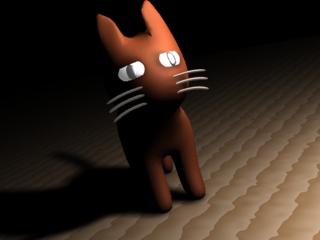移動・回転・拡大・縮小をマスターしよう!
- Lightflow > Lightflow python script
- by yuichirou yokomakura
- 2010.08.11 Wednesday 21:13
以下の参考記事「移動・回転・拡大・縮小をマスターしよう!」は、シーンを記述するうえで大変役に立ちます。ありがとうございます。
http://www3.ocn.ne.jp/~liquidz/tips/tips_lf000.htm
移動、回転、拡大・縮小は、3DCGでは変換の基礎となります。
■移動
X Y Z 座標での移動量を指定してあげます。
例えば X軸では + 8.0、Y軸では - 1.0、Z軸では + 2.0のように移動したい場合は
のようにします。
■回転
Pythonファイルの上部分、
from lightflowPM import *
の下あたりに
from math import *
を追加します。数学関数のモジュールを自動的に追加する記述です。
オブジェクトの回転の種類は3つあります。
X軸 、 Y軸 、 Z軸 のどれを基準に回転させるかで記述がちょっと異なります。
例えばX軸を基準として20度回転する場合は
のようにします。
Y軸を基準とするならば、rotationAroundYとすれば良いです。
■拡大
拡大したいオブジェクトをX軸 、 Y軸 、 Z軸で何倍するかを入力しさえすれば良いです。
例えば、あるオブジェクトを10倍の大きさにしたい場合は
とすれば良いです。
X軸 、 Y軸 、 Z軸のいずれかで、-1倍したら、反転すると思いますが、確かめてみてください。
http://www3.ocn.ne.jp/~liquidz/tips/tips_lf000.htm
移動、回転、拡大・縮小は、3DCGでは変換の基礎となります。
■移動
X Y Z 座標での移動量を指定してあげます。
例えば X軸では + 8.0、Y軸では - 1.0、Z軸では + 2.0のように移動したい場合は
s.transformBegin( transform().translation( vector3( 8.0, -1.0, 2.0 ) ) )のようにします。
■回転
Pythonファイルの上部分、
from lightflowPM import *
の下あたりに
from math import *
を追加します。数学関数のモジュールを自動的に追加する記述です。
オブジェクトの回転の種類は3つあります。
X軸 、 Y軸 、 Z軸 のどれを基準に回転させるかで記述がちょっと異なります。
例えばX軸を基準として20度回転する場合は
s.transformBegin( transform().rotationAroundX( pi * 20.0 / 180.0 ) )のようにします。
Y軸を基準とするならば、rotationAroundYとすれば良いです。
■拡大
拡大したいオブジェクトをX軸 、 Y軸 、 Z軸で何倍するかを入力しさえすれば良いです。
例えば、あるオブジェクトを10倍の大きさにしたい場合は
s.transformBegin( transform().scalling( vector3( 10.0 , 10.0 , 10.0 ) ) )とすれば良いです。
X軸 、 Y軸 、 Z軸のいずれかで、-1倍したら、反転すると思いますが、確かめてみてください。
- -
- -
